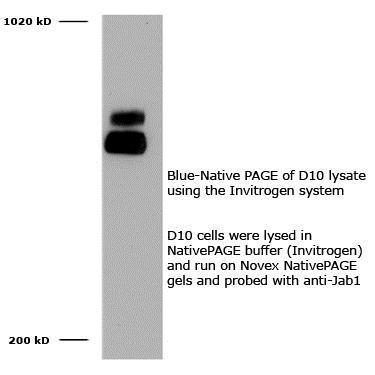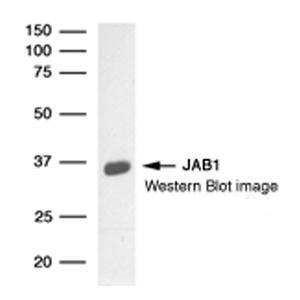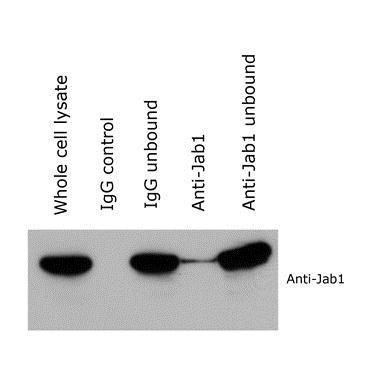Anti-JAB-1 [Clone 8H8.5]
Anti-JAB-1 [Clone 8H8.5]
Product No.: 56210
- -
- -
Clone 8H8.5 Target JAB-1 Formats AvailableView All Product Type Monoclonal Alternate Names SGN5, Signalosome subunit 5, EC 3.4.-.-, Jun activation domain-binding protein 1 Isotype Mouse IgG2a Applications IP , WB |
Data
- -
- -
Antibody DetailsProduct DetailsReactive Species Human ⋅ Mouse Host Species Mouse Immunogen Mouse JAB-1 gst-fusion protein (aa 1-334) expressed in E. coli. Product Concentration Lot Specific Formulation PBS, pH 7.4. State of Matter Liquid Product Preparation Purified by affinity on GST Storage and Handling This antibody is stable for at least one (1) year at -20°C. Avoid multiple freeze- thaw cycles. Regulatory Status Research Use Only Country of Origin USA Shipping Next Day 2-8°C Applications and Recommended Usage? Quality Tested by Leinco Immunoblotting and
Immunoprecipitation: use at 0.5-1 ug/mL. Positive controls: 293 cells and recombinant fusion protein. Each investigator should determine their own optimal working dilution for specific applications. See directions on lot specific datasheets, as information may periodically change. DescriptionDescriptionSpecificity This antibody recognizes human and mouse JAB-1. Background JAB-1 is a 38 kD protein which was originally described as a coactivator for cJUN. It is present in a large protein complex called the “signalosome†which has been proposed to play a signaling role in mammalian cells. This protein complex appears to be analogous to the COP9 complex in plants which plays an important role in light-mediated plant development. Although the specific function of JAB-1 is unclear, it appears to be involved in targeting proteins for degradation by the proteasome. Function Probable protease subunit of the COP9 signalosome complex (CSN), a complex involved in various cellular and developmental processes. The CSN complex is an essential regulator of the ubiquitin (Ubl) conjugation pathway by mediating the deneddylation of the cullin subunits of the SCF-type E3 ligase complexes, leading to decrease the Ubl ligase activity of SCF-type complexes such as SCF, CSA or DDB2. The complex is also involved in phosphorylation of p53/TP53, c-jun/JUN, IkappaBalpha/NFKBIA, ITPK1 and IRF8, possibly via its association with CK2 and PKD kinases. CSN-dependent phosphorylation of TP53 and JUN promotes and protects degradation by the Ubl system, respectively. In the complex, it probably acts as the catalytic center that mediates the cleavage of Nedd8 from cullins. It however has no metalloprotease activity by itself and requires the other subunits of the CSN complex. Interacts directly with a large number of proteins that are regulated by the CSN complex, confirming a key role in the complex. Promotes the proteasomal degradation of BRSK2. {PubMed:11285227, PubMed:11337588, PubMed:12628923, PubMed:12732143, PubMed:19214193, PubMed:20978819, PubMed:22609399, PubMed:9535219}. NCBI Gene Bank ID UniProt.org Research Area Neuroscience References & CitationsTechnical ProtocolsCertificate of Analysis |
Formats Available
 Products are for research use only. Not for use in diagnostic or therapeutic procedures.
Products are for research use only. Not for use in diagnostic or therapeutic procedures.





